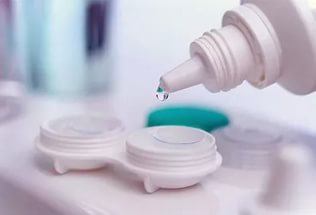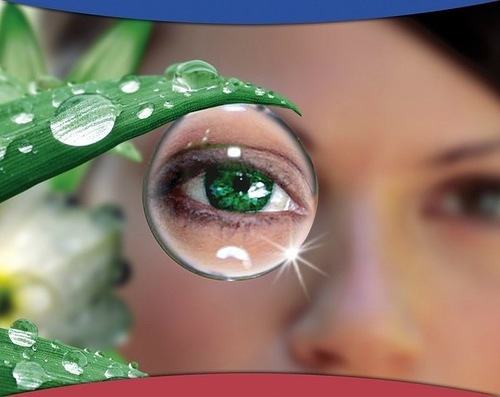How to care for contact lenses
 Eye health directly depends on the quality of care for the contact lenses you use. If instructions are violated during operation or daily care is performed incorrectly, this can lead to negative consequences and the development of eye problems. Therefore, it is necessary to effectively and promptly care for the products.
Eye health directly depends on the quality of care for the contact lenses you use. If instructions are violated during operation or daily care is performed incorrectly, this can lead to negative consequences and the development of eye problems. Therefore, it is necessary to effectively and promptly care for the products.
The content of the article
How to properly care for different types of lenses, taking into account their characteristics
Daily lenses do not require any maintenance. They are thrown away immediately after use, as they cannot be worn for more than one day.
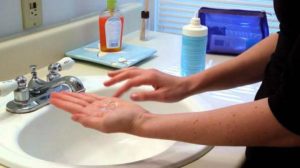 Soft ones can be designed for a month, three months or six months. In any case, they must be cleaned daily and disinfected after removal, for example, before going to bed. Today, special multifunctional solutions for soft lenses that greatly facilitate daily procedures. The soft type is divided into silicone and silicone hydrogel.
Soft ones can be designed for a month, three months or six months. In any case, they must be cleaned daily and disinfected after removal, for example, before going to bed. Today, special multifunctional solutions for soft lenses that greatly facilitate daily procedures. The soft type is divided into silicone and silicone hydrogel.
It is necessary to perform a series of sequential actions: open the container, remove the lens and place it on the palm of your hand, apply the solution to the concave and curved surfaces, gently wipe it on both sides, rinse in the solution and put in a container, fill with the solution to the mark and close the container, let it sit in the solution for 5-10 minutes.
Attention! All manipulations must be done with clean hands. Be sure to wash your hands with soap and dry them with a lint-free towel.
Rigid gas-permeable models require special care. For their production, polymethyl acrylate is used, which reduces wettability. To increase wettability, lenses are specially wiped with special compounds before each use. As a result, lipids accumulate on their surface and a plaque forms in which microorganisms can multiply. Proper care can reduce the development of plaque and minimize the risk of microorganisms developing in it.
Daily cleaning
Daily cleaning is carried out in several stages. First, remove the lens and carefully place it on your palm, then apply a few drops special solution, which is selected for each material separately. Gently wipe both surfaces with your fingertips. Fill the container with a solution selected for the material and place the lens there. To minimize the risk of contamination, you need to constantly monitor the cleanliness of the container.
Enzymatic cleaning
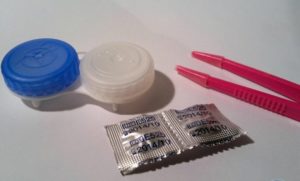 To carry it out, special enzyme tablets. They carefully remove the resulting film (enzymes, tear fluid, microcontaminants) from the surface of the lenses. The technology allows you to restore transparency and ensure wearing comfort. The methodology itself is similar to that presented above.
To carry it out, special enzyme tablets. They carefully remove the resulting film (enzymes, tear fluid, microcontaminants) from the surface of the lenses. The technology allows you to restore transparency and ensure wearing comfort. The methodology itself is similar to that presented above.
Disinfection
Disinfection is a periodic procedure that ensures comfortable wearing and performs a protective function. As a rule, it is carried out by applying special compounds: chlorhexidine, polyquad, benzalkonium chloride, and so on. A peroxide system is often used to sterilize and effectively remove deposits and contaminants. Disinfection is relevant for lenses that have a service life of more than one month. Disinfection frequency: once every one to two weeks.
The main active ingredient in disinfectant solutions is three percent hydrogen peroxide, which effectively fights a wide range of bacteria and microorganisms.
Attention! The peroxide system cannot be used on soft lenses with a high moisture content, as this may damage their structure.
Basic storage rules
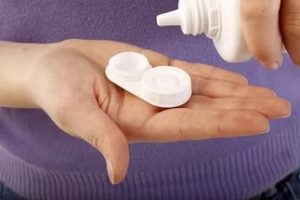 First of all, lenses cannot be kept in the open air for a long time, since the moisture contained in them begins to evaporate, and this leads to deformation and drying out. After this, the lenses will no longer be suitable for use. They need to be stored only in a specialized container.filled with solution. This avoids drying and also has a moisturizing effect. The container must always be absolutely sterile, and the liquid in it must be changed once a day.
First of all, lenses cannot be kept in the open air for a long time, since the moisture contained in them begins to evaporate, and this leads to deformation and drying out. After this, the lenses will no longer be suitable for use. They need to be stored only in a specialized container.filled with solution. This avoids drying and also has a moisturizing effect. The container must always be absolutely sterile, and the liquid in it must be changed once a day.
Caring for colored lenses: what you need to know
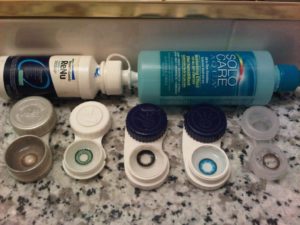 Colored contact lenses contain a thin layer of pigment that requires special care. For daily cleansing, non-aggressive media are used to gently cleanse the pigment layer. Peroxide systems are not suitable for their disinfection; more delicate compounds are needed.
Colored contact lenses contain a thin layer of pigment that requires special care. For daily cleansing, non-aggressive media are used to gently cleanse the pigment layer. Peroxide systems are not suitable for their disinfection; more delicate compounds are needed.
Related materials
Mandatory tools for proper care are a container and tweezers.There are several types of containers: for disinfection, travel and universal. Each of the listed types has a special purpose. Containers should be changed monthly and never washed with tap water. The container can only be rinsed with a solution intended for this purpose. Periodically, once a week, it is necessary to perform heat treatment of the container.
Consequences of improper care
 Following the correct cleansing technology allows you to protect yourself from vision problems and various negative health consequences. It is necessary to strictly observe personal eye hygiene and optimal wearing mode. Otherwise, inflammatory processes and the development of inflammatory diseases, such as inflammation of the eyelids, keratitis, conjunctivitis and so on, are inevitable. Also, if not cleaned, the micropores of the lenses become clogged, which reduces their transparency and worsens the effect.
Following the correct cleansing technology allows you to protect yourself from vision problems and various negative health consequences. It is necessary to strictly observe personal eye hygiene and optimal wearing mode. Otherwise, inflammatory processes and the development of inflammatory diseases, such as inflammation of the eyelids, keratitis, conjunctivitis and so on, are inevitable. Also, if not cleaned, the micropores of the lenses become clogged, which reduces their transparency and worsens the effect.
Let's sum it up
In conclusion, I would like to say that only with timely cleansing and proper care can achieve effective vision correction. Experts recommend daily cleansing immediately after removal. Saline solution cannot be used for disinfection, as it does not contain disinfectants. If the lens is damaged or has expired, it must be replaced immediately. Before going to bed, you need to place the products in the solution, hands must be clean.




